Introduction
Herbal remedies have been integral to traditional healing systems for centuries. Today, many patients continue to seek them alongside conventional medical treatments. In clinical settings, physicians and other healthcare practitioners frequently encounter questions about natural supplements and botanicals. However, the efficacy and safety of these remedies vary greatly depending on the herb, dosage, preparation, and the individual patient’s health profile.
Interest in herbal medicine has grown due to the rise of holistic wellness, greater supplement availability, and the perception that “natural” equals “safe.” While some botanicals are strongly supported by scientific evidence, others demonstrate inconsistent or weak results. This discrepancy underscores the importance of guiding patients with reliable, evidence-based information so they can make informed decisions without compromising their health.
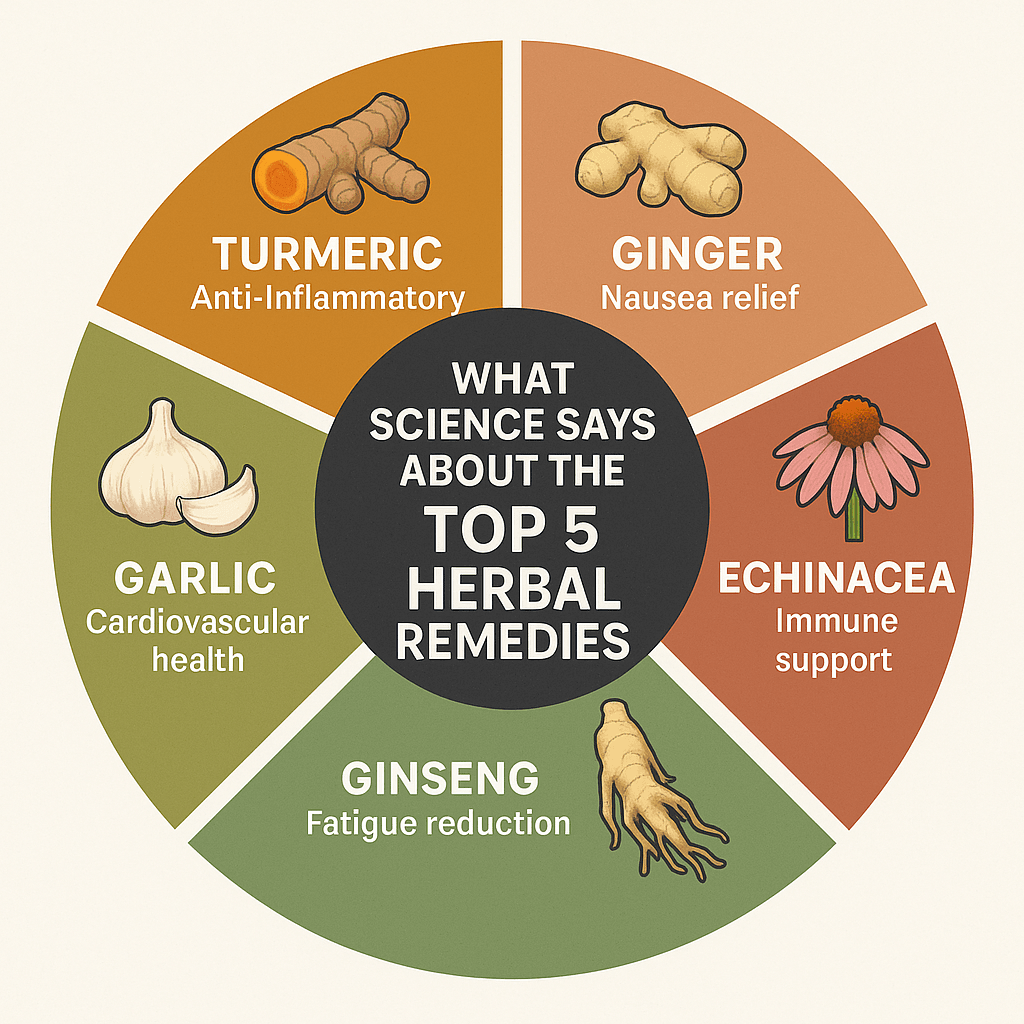
This article explores the top five herbal remedies patients most often ask about and evaluates what science currently says:
- Turmeric (Curcumin)
- Ginger
- Garlic
- Ginseng
- Echinacea
Each section outlines traditional uses, clinical evidence, safety considerations, and practical guidance. We also highlight how these remedies fit into the broader landscape of integrative medicine and provide communication tips for clinicians.
1. Turmeric (Curcumin)
Traditional Use
Turmeric (Curcuma longa) has been central to Ayurvedic and Chinese medicine for thousands of years, commonly used for inflammation, digestive issues, joint pain, and wound healing. In culinary traditions, turmeric is considered a “warming” spice that helps balance the body’s energy.
Scientific Evidence
Curcumin, turmeric’s primary bioactive compound, is widely studied for its anti-inflammatory and antioxidant properties. Systematic reviews suggest curcumin may reduce symptoms of osteoarthritis and rheumatoid arthritis, sometimes with results comparable to NSAIDs but fewer gastrointestinal side effects (Daily et al., 2016). A meta-analysis confirmed improvements in pain and function in knee osteoarthritis patients (Onakpoya et al., 2017).
Research also points to possible benefits in metabolic syndrome, cardiovascular health, cancer prevention, and mood disorders. Preclinical studies show curcumin may protect against oxidative damage in the brain, suggesting neuroprotective effects. However, curcumin suffers from poor bioavailability; pairing with piperine (black pepper extract) or specialized formulations may improve absorption.
Patient Communication Tip
Encourage patients to use turmeric in meals—curries, teas, soups—as a safe introduction. Supplements can be considered but should include absorption-enhancing formulations and be used under medical supervision.
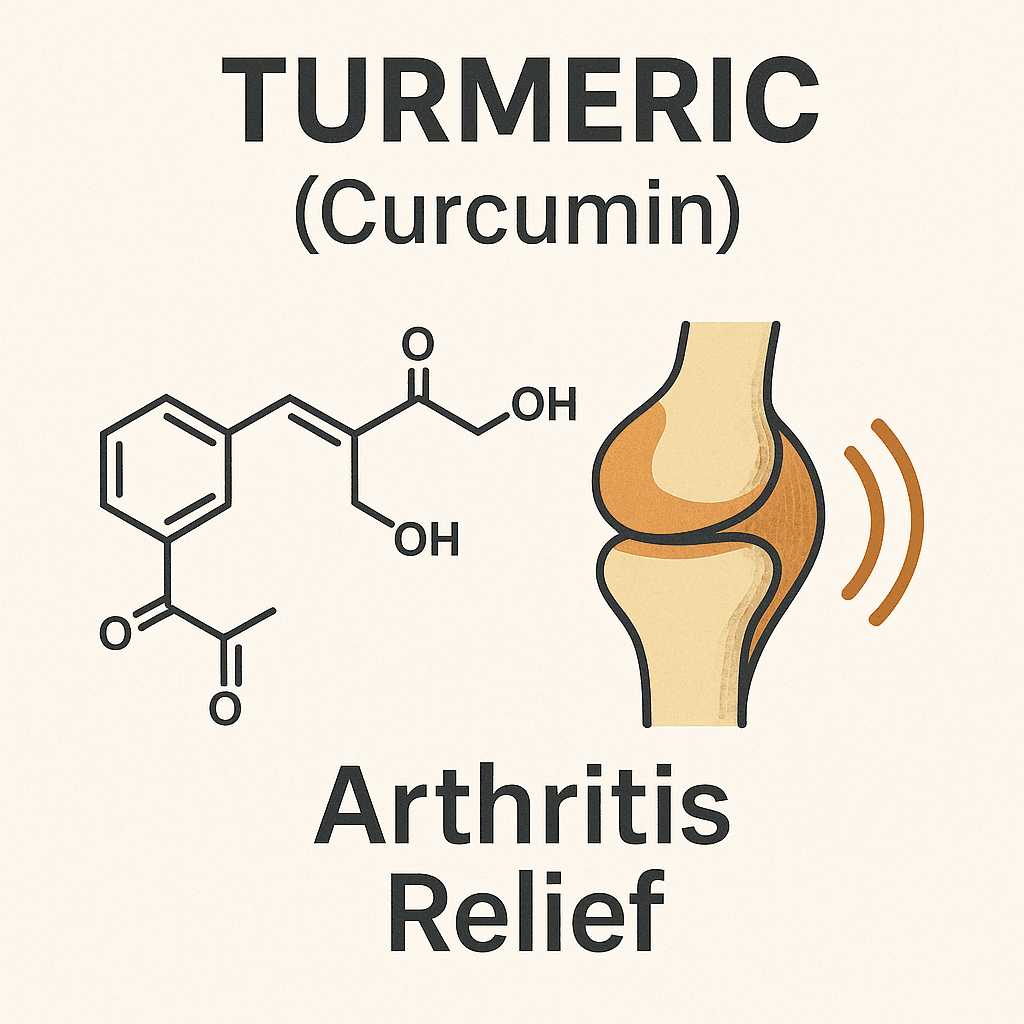
Safety Considerations
- Generally safe in dietary amounts.
- High doses may cause gastrointestinal upset or nausea.
- May interact with anticoagulants and worsen gallbladder conditions.
Practical Takeaway
Turmeric shows promising results for inflammatory conditions, particularly arthritis. Culinary use is beneficial, while supplements should be chosen carefully and monitored by healthcare professionals.
2. Ginger
Traditional Use
Garlic (Allium sativum) has long been valued for its antimicrobial and cardiovascular properties. Historically, it was believed to ward off illness, strengthen endurance, and improve circulation.
Scientific Evidence
- Cholesterol: Supplements modestly lower total cholesterol and LDL (Ried et al., 2016).
- Blood Pressure: Garlic can reduce systolic blood pressure by ~8–10 mmHg in hypertensive patients.
- Antimicrobial Effects: Strong in vitro evidence; clinical significance is less clear.
- Immune Health: Some studies suggest fewer colds, though findings are inconsistent.
- Cancer Prevention: Associations exist between garlic intake and reduced risk of gastrointestinal cancers, but causality remains uncertain.
Patient Communication Tip
Recommend ginger tea, candies, or fresh ginger in meals as effective, accessible alternatives to supplements.
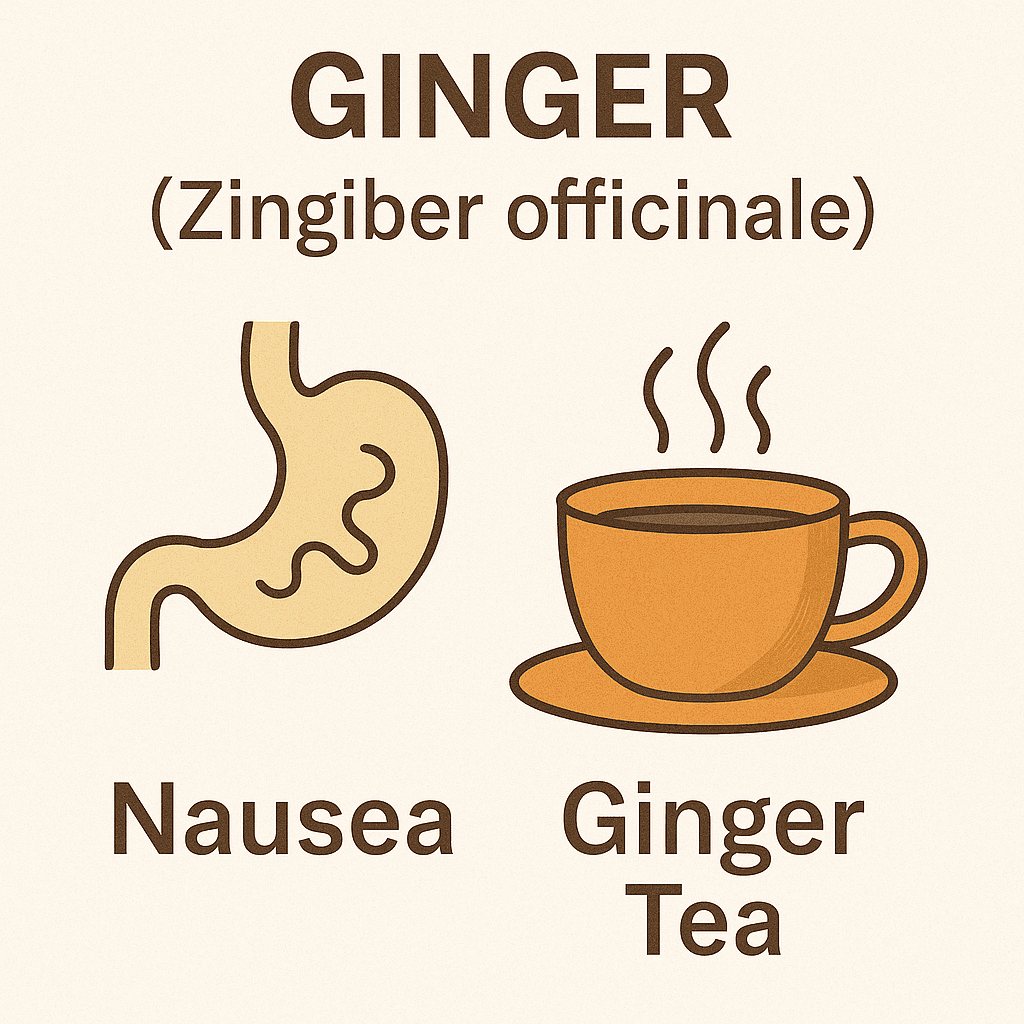
Safety Considerations
- Safe in typical food quantities.
- Large doses may cause heartburn, diarrhea, or oral irritation.
- May increase bleeding risk with anticoagulants.
Practical Takeaway
Ginger is well supported for nausea management and provides mild benefits for digestion and arthritis symptoms. It can also contribute to cardiometabolic wellness.
3. Garlic
Traditional Use
Garlic (Allium sativum) has long been valued for its antimicrobial and cardiovascular properties. Historically, it was believed to ward off illness, strengthen endurance, and improve circulation.
Scientific Evidence
- Cholesterol: Supplements modestly lower total cholesterol and LDL (Ried et al., 2016).
- Blood Pressure: Garlic can reduce systolic blood pressure by ~8–10 mmHg in hypertensive patients.
- Antimicrobial Effects: Strong in vitro evidence; clinical significance is less clear.
- Immune Health: Some studies suggest fewer colds, though findings are inconsistent.
- Cancer Prevention: Associations exist between garlic intake and reduced risk of gastrointestinal cancers, but causality remains uncertain.
Patient Communication Tip
Encourage garlic use in whole-food diets—such as Mediterranean-style diets—over supplements. Clarify that supplements should not replace prescribed medications.
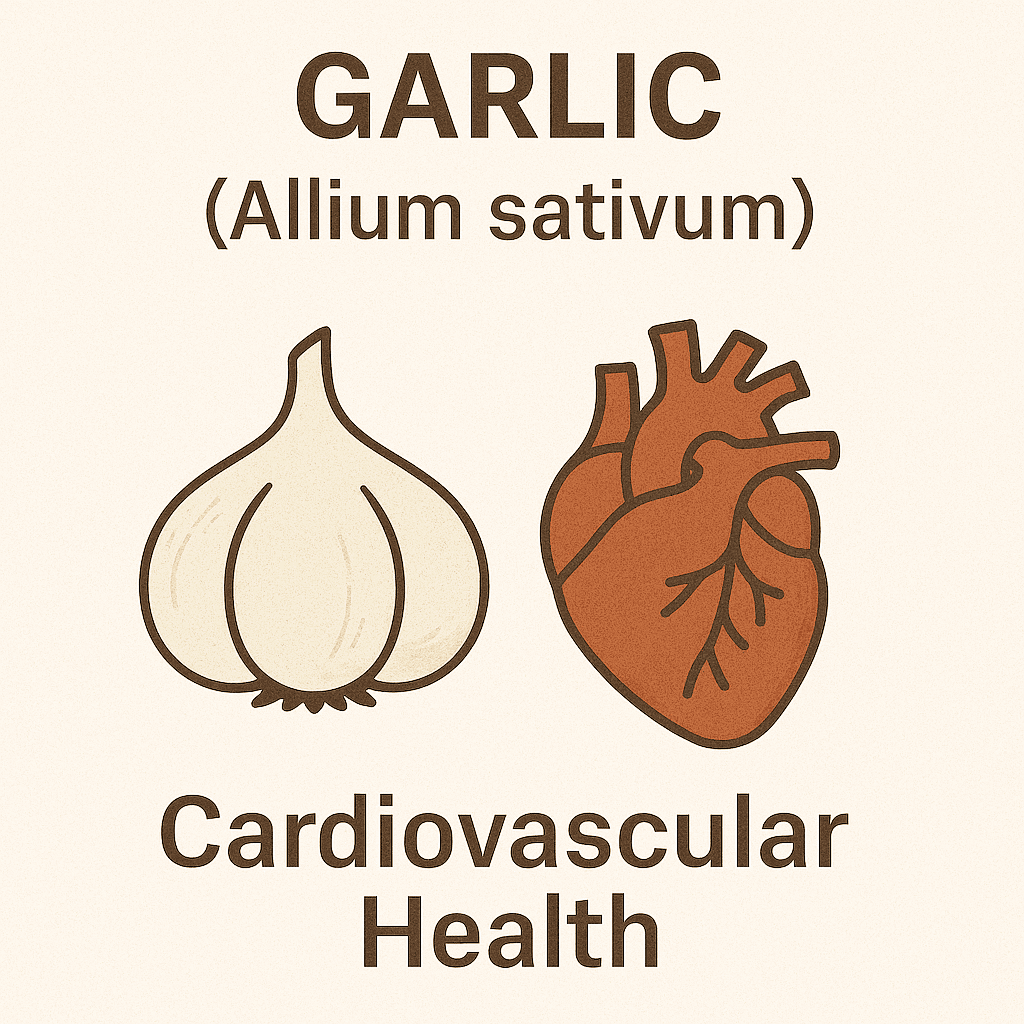
Safety Considerations
- Can cause digestive upset, allergic reactions, and strong odor.
- May increase bleeding risk, particularly with anticoagulants or prior to surgery.
Practical Takeaway
Garlic can modestly improve cardiovascular and immune health when consumed regularly as part of a balanced diet. It should complement—not replace—conventional therapy.
4. Ginseng
Traditional Use
Ginseng (Panax ginseng, Panax quinquefolius) is considered an adaptogen, traditionally used to enhance energy, reduce fatigue, improve resilience, and strengthen immunity. In Chinese medicine, it is prescribed as a vitality tonic.
Scientific Evidence
- Energy and Fatigue: May improve cancer-related fatigue and general exhaustion (Barton et al., 2013).
- Cognition: Modest improvements in attention and memory.
- Diabetes: Results are mixed, with some species showing blood sugar-lowering effects.
- Immune Support: May improve vaccine responses.
- Stress Response: Animal studies suggest modulation of stress hormones.
Patient Communication Tip
Position ginseng as a supportive, short-term aid for fatigue and stress, not as a cure-all.
Safety Considerations
- May cause insomnia, nervousness, headaches, or GI upset.
- Can interact with diabetes medications, anticoagulants, and antidepressants.

Practical Takeaway
Ginseng may be helpful for stress resilience, fatigue, and mild cognitive support. Use should be limited in duration and monitored closely for interactions.
5. Echinacea
Traditional Use
Echinacea (Echinacea purpurea) has long been used for wound healing and respiratory infections. Today, it is primarily marketed as a cold and flu remedy.
Scientific Evidence
- Colds: May slightly shorten cold duration and severity if taken early (Karsch-Völk et al., 2014).
- Prevention: Weak evidence for preventing colds.
- Immune Effects: Stimulates immune cells in vitro; clinical translation remains uncertain.
Patient Communication Tip
Advise patients that echinacea may be helpful if taken at the onset of symptoms, but its benefits are modest.
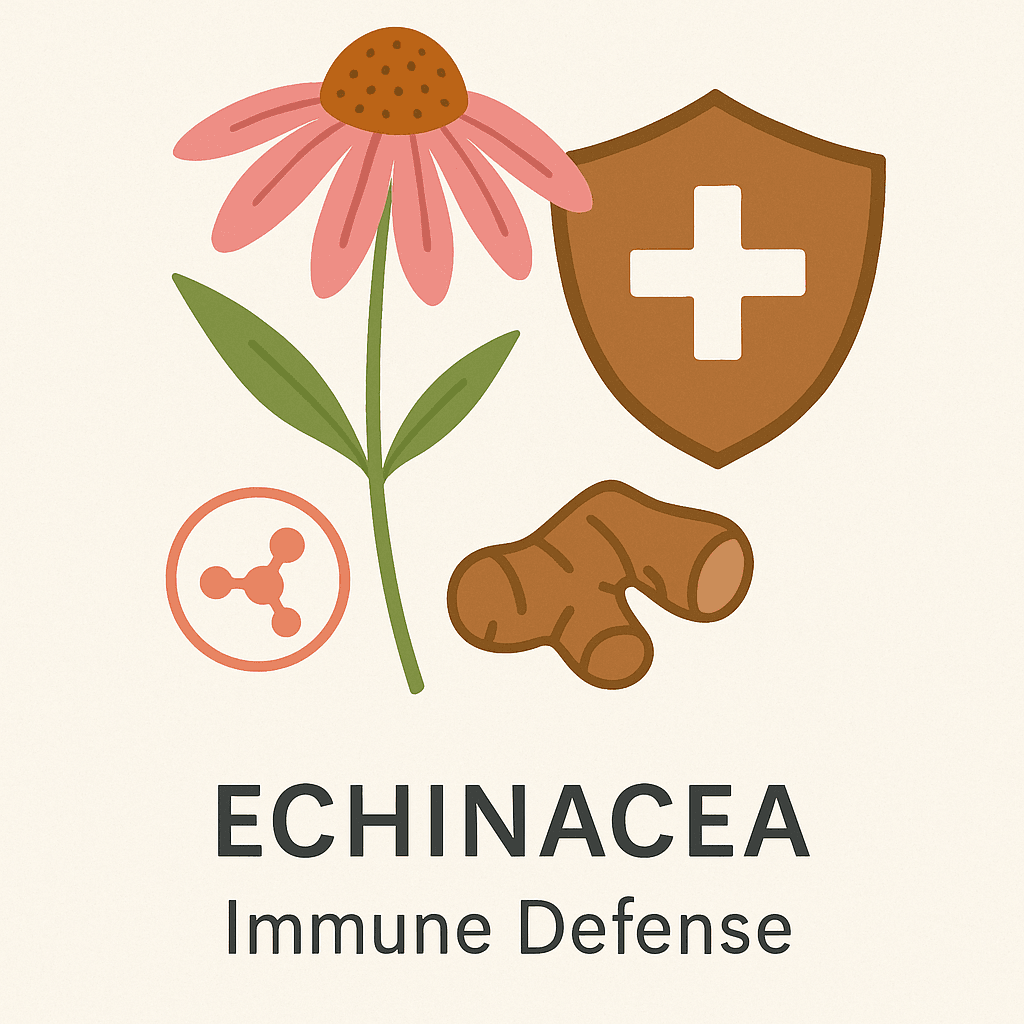
Safety Considerations
- Generally safe for short-term use.
- May trigger allergies in those sensitive to ragweed and related plants.
- Long-term safety in immunocompromised patients is unclear.
Practical Takeaway
Echinacea may provide modest support against colds, especially when started early. It should not be relied upon as a primary preventive measure.

Herbal Remedies in Integrative Medicine

Patients often use herbal remedies in combination with conventional care for chronic pain, stress, or preventive wellness. Clinicians can enhance safety and outcomes by:
- Encouraging open communication about herbal use.
- Checking for herb–drug interactions.
- Guiding patients toward reputable brands with verified quality.
- Reinforcing lifestyle modifications as the cornerstone of care.
Conclusion
Herbal remedies are an important part of modern patient self-care. Some, like turmeric and ginger, have strong evidence for specific conditions. Others, like garlic, ginseng, and echinacea, offer modest but meaningful benefits. The role of clinicians is to provide balanced, evidence-based counseling that acknowledges traditional use while clarifying the current scientific consensus.
Key Messages for Patients
- Herbal remedies can support but not replace medical treatments.
- Evidence varies by herb; check for quality, dosage, and safety.
- Consult healthcare providers before starting supplements, especially if taking medications or managing chronic illness.
- Lifestyle measures—nutrition, exercise, stress management—remain the foundation of wellness. Herbal supplements are best used as complementary tools.
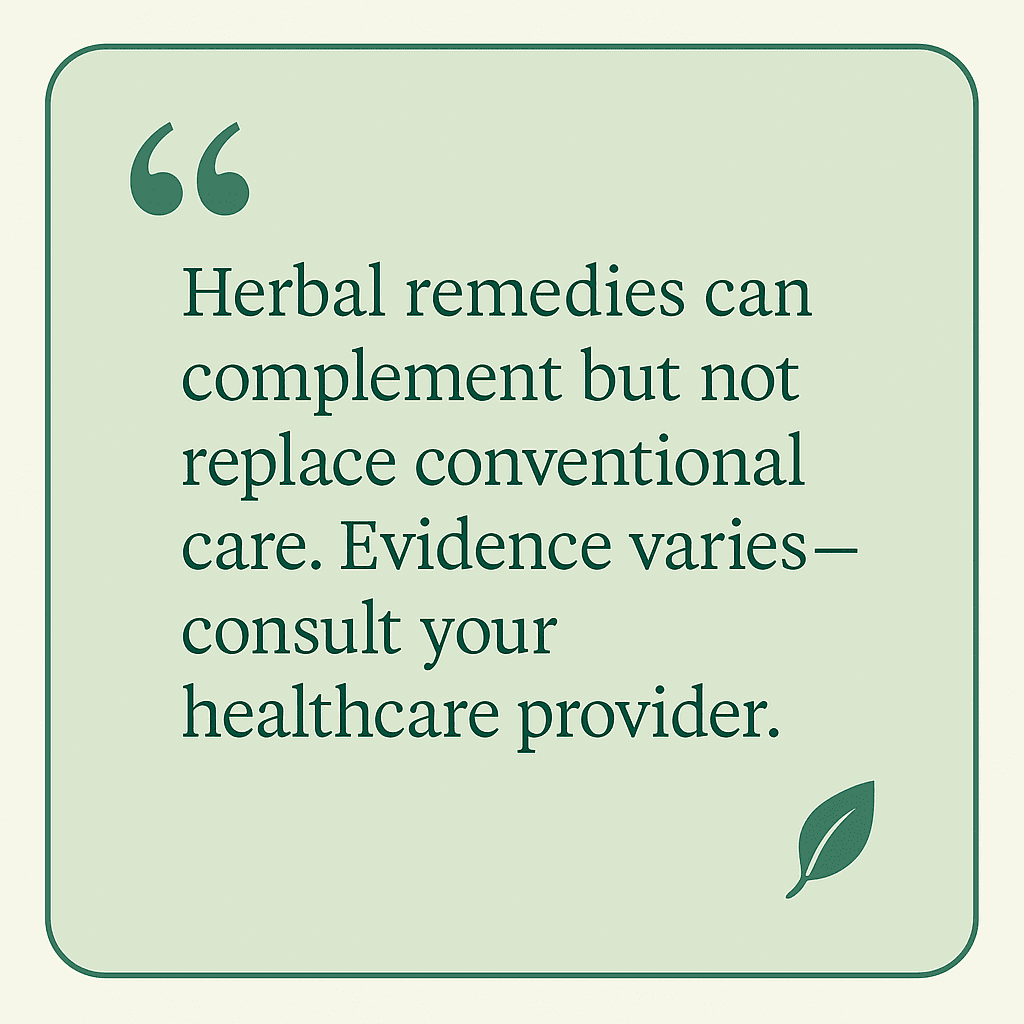
References
- Daily, J. W., Yang, M., & Park, S. (2016). Efficacy of Turmeric Extracts and Curcumin for Alleviating the Symptoms of Joint Arthritis: A Systematic Review and Meta-Analysis of Randomized Clinical Trials. Journal of Medicinal Food, 19(8), 717-729.
- Kristopher Paultre, William Cad, Daniel Hernandez, John Reynolds, Dylan Greif, Thomas Michael Best (2021). Therapeutic effects of turmeric or curcumin extract on pain and function for individuals with knee osteoarthritis: a systematic review. NCBI NIM PubMed, 7(1):e000935.
- Viljoen, E., Visser, J., Koen, N., & Musekiwa, A. (2014). A Systematic Review and Meta-Analysis of the Effect of Ginger on Nausea and Vomiting in Pregnancy. Nutrition Journal, 13(20).
- Ried, K., Toben, C., & Fakler, P. (2016). Effect of Garlic on Serum Lipids: An Updated Meta-Analysis. Nutrition Reviews, 74(11), 691–706.
- Barton, D. L., et al. (2013). Panax Ginseng (American Ginseng) Improves Cancer-Related Fatigue: Results of a Randomized, Double-Blind Trial. Journal of the National Cancer Institute, 105(16), 1230–1238.
- Karsch-Völk, M., Barrett, B., Kiefer, D., Bauer, R., & Ardjomand-Woelkart, K. (2014). Echinacea for Preventing and Treating the Common Cold. Cochrane Database of Systematic Reviews, Issue 2.
Holistic Wellness Presence Kit
Unlock your clinic’s digital potential. Download the Holistic Wellness Presence Kit today and start building an online presence that attracts and retains patients.
Holistic Wellness Presence KitFree Audit / Consultation
Not sure how strong your online presence is? Book a Free Audit and get actionable insights tailored to your healthcare practice.
Book a Free Consultation


